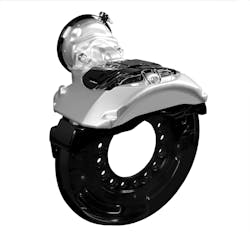The case for air disc brakes
Air disc brakes offer several advantages over traditional drum brakes, say officials at WABCO, a global supplier of technologies and services that improve the safety, efficiency and connectivity of commercial vehicles (www.wabco-auto.com)
Such advantages include:
● Stable braking performance.
● Virtually no fading and/or pulling.
● Excellent downhill performance.
● Reduced stopping distance.
● Improved driver comfort.
“Additionally, air disc brakes are more reliable than drum brakes, which require more maintenance,” say the officials.
Fleets should also keep the following considerations in mind when evaluating air disc brakes and comparing them to conventional drum brakes:
● Air disc brakes provide a stopping distance that is as much as 15 percent better than that required by Federal Motor Vehicle Safety Standard 121, Air Brake Systems, (FMVSS 121) and 10 percent better than drum brakes.
● Air disc brake adjustment is done internally, resulting in fewer Compliance, Safety and Accountability (CSA) violations by eliminating out-of-adjustment situations.
● Air disc brake service intervals are up to twice as long as drum brakes. It is estimated that the brake pads of four air disc brake wheel ends can be exchanged in the time of one drum lining wheel end. Air disc brake pads, by some estimates, need servicing every 500,000 to 600,000 miles and rotors up to one million miles.
